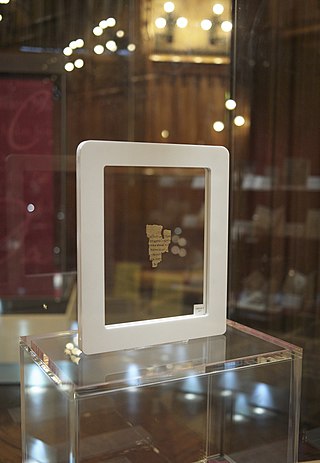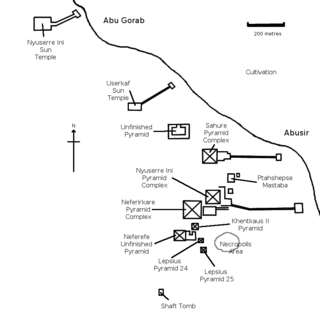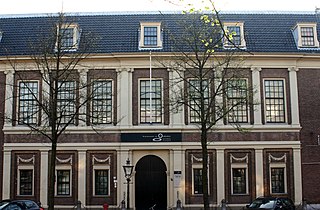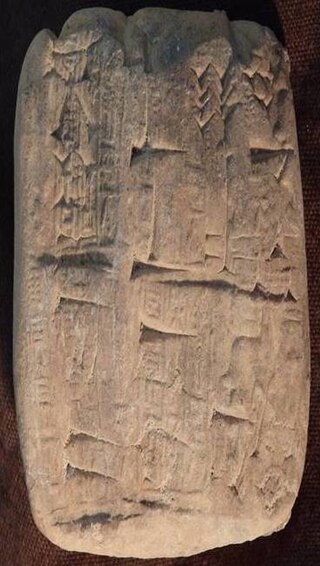
Roberta Mazza is a Papyrologist and Associate Professor at the Department of Cultural Heritage at the University of Bologna.

Roberta Mazza is a Papyrologist and Associate Professor at the Department of Cultural Heritage at the University of Bologna.
Mazza received her PhD from the University of Bologna. [1]
Mazza is an expert on Egypt during the Roman and Byzantine periods. She co-curated an exhibition of papyri, portraits and Egyptian contemporary art at the John Rylands Library in 2012, and she has published papyri from the John Rylands collection. [2] Her most recent book, Stolen Fragments: Black Markets, Bad Faith, and the Illicit Trade in Ancient Artefacts, was published in 2024 by Redwood Press and Stanford University Press. The book examines the purchase of a fragment of papyrus dating to the second century CE containing lines from Paul's Letter to the Romans by Steve Green, the billionaire owner of the craft chain Hobby Lobby. The fragment derived from the holdings of Oxford University and had been sold without the consent of the owners.
Before taking up a position at the University of Bologna in 2022, Mazza was a lecturer in Graeco-Roman material culture at the Department of Classics, Ancient History, Archaeology and Egyptology of the University of Manchester from 2009. [3] She was previously the Tipton Distinguished Visiting Chair in Catholic Studies (Department of Religious Studies) at the University of California, Santa Barbara. Mazza has written for Hyperallergic and Eidolon, and her work has been covered by The Guardian . [4] [5] [6]

Papyrus is a material similar to thick paper that was used in ancient times as a writing surface. It was made from the pith of the papyrus plant, Cyperus papyrus, a wetland sedge. Papyrus can also refer to a document written on sheets of such material, joined side by side and rolled up into a scroll, an early form of a book.

The Elephantine Papyri and Ostraca consist of thousands of documents from the Egyptian border fortresses of Elephantine and Aswan, which yielded hundreds of papyri and ostraca in hieratic and demotic Egyptian, Aramaic, Koine Greek, Latin and Coptic, spanning a period of 100 years in the 5th to 4th centuries BCE. The documents include letters and legal contracts from family and other archives, and are thus an invaluable source of knowledge for scholars of varied disciplines such as epistolography, law, society, religion, language and onomastics. The Elephantine documents include letters and legal contracts from family and other archives: divorce documents, the manumission of slaves, and other business. The dry soil of Upper Egypt preserved the documents.

The Rylands Library Papyrus P52, also known as the St John's fragment and with an accession reference of Papyrus Rylands Greek 457, is a fragment from a papyrus codex, measuring only 3.5 by 2.5 inches at its widest, and conserved with the Rylands Papyri at the John Rylands University Library Manchester, UK. The front (recto) contains parts of seven lines from the Gospel of John 18:31–33, in Greek, and the back (verso) contains parts of seven lines from verses 37–38. Since 2007, the papyrus has been on permanent display in the library's Deansgate building.

The Joseph Smith Papyri (JSP) are Egyptian funerary papyrus fragments from ancient Thebes dated between 300 and 100 BC which, along with four mummies, were once owned by Joseph Smith, the founder of the Latter Day Saint movement. Smith purchased the mummies and papyrus documents from a traveling exhibitor in Kirtland, Ohio in 1835. Smith said that the papyrus contained the records of the ancient patriarchs Abraham and Joseph.

Oxyrhynchus, also known by its modern name Al-Bahnasa, is a city in Middle Egypt located about 160 km south-southwest of Cairo in Minya Governorate. It is also an important archaeological site. Since the late 19th century, the area around Oxyrhynchus has been excavated almost continually, yielding an enormous collection of papyrus texts dating from the Ptolemaic Kingdom and Roman Egypt. They also include a few vellum manuscripts, and more recent Arabic manuscripts on paper.

The Bodmer Papyri are a group of twenty-two papyri discovered in Egypt in 1952. They are named after Martin Bodmer, who purchased them. The papyri contain segments from the Old and New Testaments, early Christian literature, Homer, and Menander. The oldest, P66 dates to c. 200 AD. Most of the papyri are kept at the Bodmer Library, in Cologny, Switzerland outside Geneva.

The Papyrology Collection of the University of Michigan Library is an internationally respected collection of ancient papyrus and a center for research on ancient culture, language, and history. With over 7,000 items and more than 10,000 individual fragments, the Collection is by far the largest collection of papyrus in the country, and offers a glimpse into the everyday life and language of the ancient world. Of keen interest to historians, linguists, classicists, philosophers, archaeologists, as well as others, the collection includes biblical fragments, religious writings, public and private documents, private letters, and writings on astronomy, astrology, mathematics, and magic. The papyri span nearly two millennia of history, dating from about 1000 BC to AD 1000, with the majority dating from the third century BC to the seventh century AD.

The Oxyrhynchus Papyri are a group of manuscripts discovered during the late nineteenth and early twentieth centuries by papyrologists Bernard Pyne Grenfell and Arthur Surridge Hunt at an ancient rubbish dump near Oxyrhynchus in Egypt.

The Rylands Papyri are a collection of thousands of papyrus fragments and documents from North Africa and Greece housed at the John Rylands University Library, Manchester, UK. The collection includes the Rylands Library Papyrus P52, also known as the "St John's fragment", a fragment from a papyrus codex, generally accepted as the earliest extant record of a Canonical gospel.
Dirk D. Obbink is an American papyrologist and classicist. He was Lecturer in Papyrology and Greek Literature in the Faculty of Classics at Oxford University until 6 February 2021, and was the head of the Oxyrhynchus Papyri Project until August 2016. Obbink was also a fellow and tutor in Greek at Christ Church Oxford, from which role he was suspended in October 2019, as a result of allegations that he had stolen some of the Oxyrhynchus papyri and sold them to the Museum of the Bible.

The Abusir Papyri are the largest papyrus findings to date from the Old Kingdom in ancient Egypt. The first papyri were discovered in 1893 at Abu Gorab near Abusir in northern Egypt. Their origins are dated to around the 24th century BC during the Fifth dynasty of Egypt, making them, even though often badly fragmented, among some of the oldest surviving papyri to date. Later on, a large number of additional manuscript fragments were discovered in the area.

Papyrus Rylands 458 is a manuscript of the Pentateuch in the Greek Septuagint version of the Hebrew Bible. It is a roll made from papyrus, which has survived in a very fragmentary condition. It is designated by the number 957 on the list of Septuagint manuscripts according to the numbering system devised by biblical scholar Alfred Rahlfs. Using the study of comparative writing styles (palaeography), the manuscript has been dated to the middle of the 2nd century BCE.

Insinger Papyrus is a papyrus find from ancient Egypt and contains one of the oldest extant writings about Egyptian wisdom teachings (Sebayt). The manuscript is dated to around the 1st century BC according to the Rijksmuseum van Oudheden in Leiden where the main part is kept. Other sources suggest it dates to the 1st century AD, and to the 3rd century BC. Fragments have also been found in other collections.
Papyrus Oxyrhynchus 69 is a complaint about a robbery, written in Greek. The manuscript was written on papyrus in the form of a sheet. It was discovered by Grenfell and Hunt in 1897 in Oxyrhynchus. The document was written on 21 November 190. Currently it is housed in the Institute for the Study of Ancient Cultures at the University of Chicago. The text was published by Grenfell and Hunt in 1898.
Papyrus Oxyrhynchus 267 is a fragment of an Agreement of Marriage in Greek. It was discovered in Oxyrhynchus. The manuscript was written on papyrus in the form of a sheet. It is dated to 22 May 37. Currently it is housed in the Milton S. Eisenhower Library of the Johns Hopkins University in Baltimore.

Papyrus Oxyrhynchus 282 is a fragment of a Complaint against a Wife, in Greek. It was discovered in Oxyrhynchus. The manuscript, written on papyrus in the form of a sheet, is dated between 26 January 29 – 22 May 37. It is housed in the Beinecke Rare Book and Manuscript Library of the Yale University in New Haven.

Martin Bommas is a German Egyptologist, archaeologist, and philologist. He is a professor and Museum Director at the Macquarie University History Museum in Sydney, Australia and the Director of the Qubbet el-Hawa Research Project (QHRP) in Aswan, Egypt. He has published widely on ancient Egyptian mortuary liturgies, rituals and religious texts spanning the Old Kingdom to the Christian era. In archaeology, he has examined the Old and Middle Kingdom settlement remains and the 18th Dynasty temple of Khnum at Elephantine as well as the Old and Middle Kingdom Lower Necropolis at Qubbet el-Hawa. As a museum director, his focus is on historical anthropology, decolonisation and the repatriation of illicitly trafficked artefacts.
Papyrus Oxyrhynchus 581 is a papyrus fragment written in Ancient Greek, apparently recording the sale of a slave girl. Dating from 29 August 99 AD, P. Oxy. 581 was discovered, alongside hundreds of other papyri, by Bernard Pyne Grenfell and Arthur Surridge Hunt while excavating an ancient landfill at Oxyrhynchus in modern Egypt. The document's contents were published by the Egypt Exploration Fund in 1898, which also secured its donation to University College, Dundee, later the University of Dundee, in 1903 – where it still resides. Measuring 6.3 x 14.7 cm and consisting of 17 lines of text, the artifact represents the conclusion of a longer record, although the beginning of the papyrus was lost before it was found. P. Oxy. 581 has received a modest amount of scholarly attention, most recently and completely in a 2009 translation by classicist Amin Benaissa of Lady Margaret Hall, Oxford.

The Hobby Lobby smuggling scandal started in 2009 when representatives of the Hobby Lobby chain of craft stores received a large number of clay bullae and tablets originating in the ancient Near East. The artifacts were intended for the Museum of the Bible, funded by the Evangelical Christian Green family, which owns the Oklahoma-based chain. Internal staff had warned superiors that the items had dubious provenance and were potentially looted from Iraq.
The Papyrus Carlsberg Collection is a collection of Egyptian papyri in the possession of the University of Copenhagen. It was founded in the early 1930s by Prof H. O. Lange with the help of funds from the Carlsberg Foundation. The majority of the documents were purchased between 1931 and 1938. Later on, in 1939, the foundation, with the consent of the Ministry of Education and the headmaster, presented its collection in the University of Copenhagen.